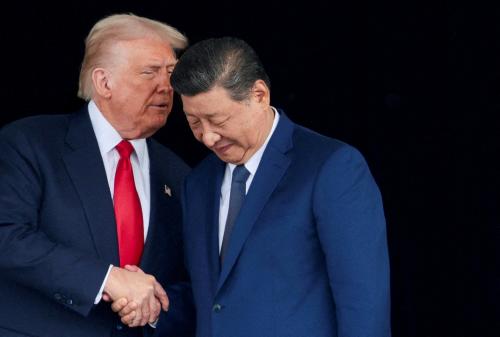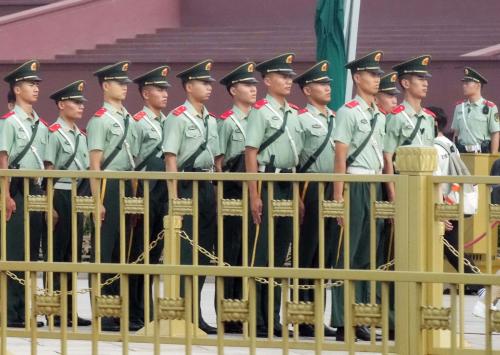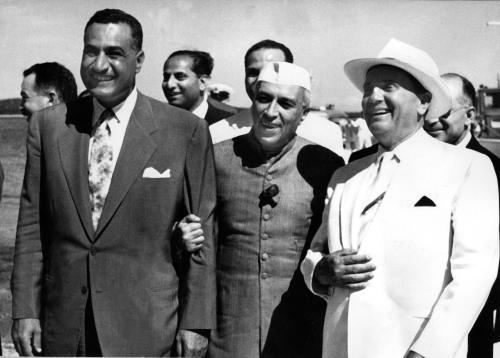China’s recently concluded Fourth Plenum juxtaposed extensive purges and personnel turnover with policy continuity, as we discussed prior to the plenum. The plenum lasted from October 20 to October 23, concluding with the Chinese Communist Party leadership purging 10 members of the Central Committee, which, before the plenum, comprised the party’s top 205 officials, including 42 members of the military high command. On the policy side, this plenum was especially consequential because the party leadership provided its recommendations for the 15th Five-Year Plan (FYP), which will guide China’s development from 2026-2030. The plenum’s recommendations will feed into the final draft of the FYP, which will be formally approved by China’s National People’s Congress, its titular legislature, during its annual meeting in the first week of March. In the meantime, observers should expect additional signals about Beijing’s economic priorities for the coming year at the annual Central Economic Work Conference, which typically occurs in early December.
Policy: Assessing the party’s recommendations for the 15th Five-Year Plan (2026-2030)
Continuity. The plenum produced a series of major documents pertaining to the next FYP, including the plenum communique, the Central Committee’s recommendations, and Xi Jinping’s explanation, as well as a series of remarks by other top officials. The plenum communique signaled some subtle shifts in policy priorities, but the main theme was one of continuity. For example, in the last FYP, the party leadership made technological self-reliance the first priority, while the second priority was building up the modern industrial system—including its advanced manufacturing and high technology sectors. This year’s recommendations for the next FYP flipped that order.
Xi’s focus on continuity makes sense: he is now well into his third term and can see tangible progress on the techno-industrial ambitions that have animated his economic agenda. While China’s economy still suffers from pronounced weaknesses—most notably, the real estate sector’s continuing contraction and deflation driven by intense domestic competition that has cut into companies’ profits—Xi likely judges that these are problems to be managed rather than enduring impediments to China’s economic development.
Confidence. While the plenum introduced little new substance, the tone of its authoritative documents was both more confident and more urgent than those released before the last FYP in 2020. This may reflect Beijing’s assessment that its efforts to fortify China against U.S. tariffs and identify points of leverage over Washington have been surprisingly effective during this second trade war. Xi and other senior officials also expressed greater confidence about China’s ability to shape the international environment in China’s favor, raising “achieving win-win cooperation” with the world from the ninth to the seventh priority. The Central Committee’s recommendations assert that “a profound shift is taking place in the international balance of power” and cites accelerating “breakthroughs … in the new round of technological revolution and industrial transformation” as creating “positive factors” for China to act more proactively abroad.
This confidence is underpinned by an acknowledgment that Chinese firms are producing globally competitive artificial intelligence models, dominating renewable energy markets, seizing global market share in electric vehicles, and building semiconductor production capacity, particularly in legacy chips. While the party leadership acknowledged the challenges facing China, it also exhorted cadres to approach them with “courage.” Notably, the plenum’s recommendations document lauded Beijing’s development over the past five years as “extraordinary and remarkable,” a marked upgrade over the 14th FYP’s description of the 13th FYP period as “decisive” and remaining “core to its original aspiration.” The slightly lower priority given to self-reliance by the 15th FYP suggests that the party feels it has made significant progress in insulating supply chains and advancing its techno-industrial base throughout the 14th FYP period—which was drafted in a milieu, as well as characterized by zero-COVID lockdowns, a bloated property sector, and an unpredictable trade war—and that it will continue to do so.
Urgency. The plenum documents conveyed a greater sense of urgency to accomplish the party’s goals. Xi himself noted in his explanation that the next five years will be critical for “basically achieving” socialist modernization by 2035. As China analyst Andrew Polk highlighted at a recent Brookings event focused on the Fourth Plenum, that sense of urgency likely reflects Beijing’s need to complete China’s difficult economic transition before demographic decline further hinders economic growth. That transition entails an ongoing and painful shift from a growth model centered on investment, labor, and real estate to one built on China’s deepening techno-industrial prowess. Polk has pointed out that if the 15th FYP’s ambitions are realized, China will command an even greater share of global manufacturing, amplifying the impact of the current trade imbalances resulting from China’s overcapacity. China already accounted for 29% of global manufacturing in 2023, and further gains could have significant global ramifications.
Beijing’s decision to double down on its current model underscores how ineffectual U.S. tariffs and European trade measures have been in prompting Beijing to reconsider its economic policy. In fact, the potency of these U.S. and allied tools may only be diminishing over time. For instance, even after the Trump administration’s imposition of tariffs on China this year, China’s net exports actually increased in the subsequent months before unexpectedly contracting last month.
Consumption? The plenum communique notably diverged from last year’s Central Economic Work Conference, which proclaimed expanding domestic demand as the party’s top economic priority—a prioritization that has been echoed over the subsequent year in authoritative party and state pronouncements. Instead, consumption is now identified as the fifth priority—exactly the same spot it occupied in the previous FYP. Xi remains loath to expand China’s welfare commitments at a time when China’s demographic decline will already squeeze its finances, especially since China currently lacks the fiscal space to roll out additional stimulus measures that do more than stabilize China’s macroeconomy. As economic analyst Gerard DiPippo has pointed out, the leadership believes that “consumption is an outcome to be achieved through improving the productive side of the economy.”
Personnel: Purges confirmed, with portents of more to come
The plenum’s most striking and dramatic developments came on the personnel side. The current Central Committee began its term in 2022 with 205 full members and 171 alternates, but only 168 full members and 147 alternates attended last month’s plenum—the lowest turnout in the post-Mao era, according to China scholar Neil Thomas. Prior to the Fourth Plenum, three full Central Committee members had been purged, and three alternates were elevated to full members. At the Fourth Plenum, the leadership purged 10 full Central Committee members and four alternates, while one full member passed away last December.
The leadership promoted 11 alternates to become full Central Committee members at the Fourth Plenum to backfill the newest vacancies, but in the process skipped over eight alternate members who had garnered more votes at the Party Congress and therefore should have been ahead in the queue for promotion to the full Central Committee. These individuals are included in the appendix below. Altogether, an additional 26 full and 16 alternate Central Committee members—in addition to the 14 who were purged and 1 who passed away—were conspicuously absent from the plenum. This uncomfortable and deliberate snub likely portends further purges.
The military
The purges left their most conspicuous mark on the People’s Liberation Army (PLA) high command, which has been more than decimated by Xi’s purges and saw eight members of its ranks ousted in the week before the plenum, including former Central Military Commission (CMC) Vice Chairman He Weidong, who had been missing since March but had not actually been removed from office until October. This announcement cleared the decks for additional personnel moves at the plenum since only a plenum of the Central Committee can make personnel changes to the CMC.
These purges have extirpated a segment of the current generation of senior PLA officers, leaving behind an unbalanced CMC structure and a high command riddled with conspicuous vacancies. Some observers have attributed Xi’s purge of the high command to factional infighting within the PLA, but unfortunately, that claim lacks sufficient hard evidence. While several officers from the 31st Group Army—including two CMC members—were notably caught up in this most recent round of purges, Xi’s dragnet extended far beyond that group army’s alumni, suggesting multiple causes and indicating that any factional element was embedded in a broader effort to clean house. As John Culver and Jonathan Czin argued in Foreign Affairs, Xi wants to ensure he can employ violence with confidence—whether against Taiwan or to defend the party at home—but he doubts the PLA’s willingness and ability to do so.
Central Military Commission structural distortions. The Central Committee’s decisions at the plenum have warped the structure of the Party’s supreme military body, the CMC. The CMC is now a diamond-shaped body with one chairman (Xi), two vice chairmen (Zhang Shengmin and Zhang Youxia), and only one regular member (Liu Zhenli). This unbalanced structure is remarkable when one considers that Xi expended so much political capital in his first term rationalizing and streamlining the PLA high command. At the start of Xi’s third term, the CMC comprised Xi as chairman, two vice chairmen, and four members: the minister of national defense, chief of the Joint Staff Department, the director of the Political Work Department, and the secretary of the Discipline Inspection Commission. This composition reflected Xi’s dual emphasis on operational proficiency and ensuring political rectitude. Now, the position of defense minister has been evicted from the CMC, and the Political Work Department lacks a leader.
Photo credits: Xi Jinping (REUTERS/Maxim Shemetov/Pool); Zhang Youxia (REUTERS/Tingshu Wang); He Weidong (Ichiro Ohara/The Yomiuri Shimbun via Reuters Connect); Zhang Shengmin (REUTERS/Florence Lo/File Photo); Li Shangfu (Ichiro Ohara/The Yomiuri Shimbun via Reuters Connect); Liu Zhenli (REUTERS/Florence Lo/File Photo); Mao Hua (Greg Baker/Pool via REUTERS)
- The Central Committee elevated General Zhang Shengmin to CMC vice chairman, which endows the CMC with a more traditional vice chairman structure—with one vice chairman clearly responsible for party affairs and the other devoted to operational matters. However, the leadership also made the unusual decision to have Zhang retain his position as head of the CMC Discipline Inspection Commission (the military’s top anti-corruption body) rather than installing a new officer in this role. Some observers have speculated that Xi may have personal ties to Zhang, since Zhang rose through the ranks in China’s northwest, where Xi’s father served. However, that nexus seems tenuous at best: the evidence of a connection is indirect, and more concretely, Xi elected not to grant Zhang his predecessor’s concurrent seat on the Politburo, a highly unusual move that breaks with tradition and is hardly a sign of Xi’s confidence in Zhang.
- Xi also chose not to replace Miao Hua as director of the Political Work Department—contrary to our expectation in our pre-plenum assessment that Xi would fulfill this crucial role, which, organizationally, is an important node of the party’s control over the military. The leadership’s choice to leave this position conspicuously vacant suggests that Xi does not trust the current cohort of senior political commissars who would have been eligible for the job, and it is a sign that further purges will afflict the PLA’s political commissariat. Indeed, two political commissars at the Theater Command grade—the grade eligible to replace Miao—have been purged, and as many as seven additional commissars are rumored to be missing, though we cannot corroborate these rumors.
The PLA officers on the Central Committee: Altogether, eight PLA members on the Central Committee out of 42 were purged at this plenum, bringing the total number of purged PLA full and alternate members of this Central Committee to 12, out of the original 67 that started in 2022.
Notably, five senior officers who were rumored to be missing before the plenum were in fact purged. Just as importantly, however, at least 17 senior officers who were rumored to be missing before the plenum were not purged. This outcome underscores both the fluidity of the high command’s political dynamics and the perils of prognosticating about Chinese politics based on purported absences and rumors. In this instance, absence of evidence is not evidence of absence.
Civilians
The purges of civilian party members, by contrast, were relatively more prosaic, with the leadership not making any sudden moves before the plenum and confirming the purges of officials who had already been ousted. As with the military, the leadership did bypass three civilian alternate members of the Central Committee for promotion: Vice Minister of Education Wang Jiayi, Communist Party Secretary of Xi’an Fang Hongwei, and Deputy Secretary of the Yunnan Provincial Committee Shi Yugang. Since the plenum, Fang Hongwei has already come under investigation, meaning that the passing over of these officials is likely a portent of further purges to come.
Conclusion
The plenum’s outcomes suggest that Xi sees the party’s policies as sound but that too many of its personnel are rotten—especially within the PLA, which has absorbed the most extensive high-level purges. Indeed, as Minxin Pei notes, Xi’s anti-corruption campaign has accelerated across the entire party apparatus in his third term, with 889,000 party members disciplined for various infractions in 2024, the highest number of Xi’s entire rule.
That such sweeping purges are occurring more than a decade into Xi’s rule—after he had ample time to pick the party’s leadership—is striking. Although these purges bred rumors of Xi’s weakening grip on power this summer, no visible moves against Xi have materialized. More plausibly, Xi’s ability to dispose of such powerful party and military leaders reflects his dominance. The reasons behind the individual disciplinary cases are likely quite varied, but collectively, they suggest that Xi is losing patience with rather than control over the leaders who ascended the party ranks during his predecessors’ his tenures.
The conspicuous absence of so many senior officials also suggests that Xi is not yet done scouring the ranks of the leadership. Although some purged figures—like He Weidong and former Foreign Minister Qin Gang—were Xi’s own handpicked appointees, Xi’s relationship with these individuals may not have been especially deep. Xi made them, and he could break them.
So far, Xi’s closest lieutenants—including every member of the Politburo Standing Committee except Wang Huning, as well as CMC Vice Chairman Zhang Youxia—have been spared. If any of them were purged before the next Party Congress in 2027, it would mark a potentially seismic shift in China’s elite politics. Such a move could even signal an oft-rumored but perennially absent “backlash” against Xi from within the party’s leadership—or, alternatively, incite Xi’s wrath. At a more mundane level, China analyst Chris Johnson has noted that since Xi has already warped China’s political calendar to his purposes, he could convene an additional “pocket plenum” in the next couple of years to fill the mounting vacancies at the top and rectify the unbalanced military command structure now in place.
The plenum’s core motif—intensifying political turbulence and policy continuity—will likely be a chief feature of Xi’s expected fourth term beginning in 2027. As Jonathan Czin has argued elsewhere, Xi’s age will force the succession issue to the forefront and fuel jockeying within Zhongnanhai, the government compound in Beijing. The real danger for the party is if succession politicking starts to infect the policymaking process—a development that could produce more erratic and volatile policy, as has occurred during previous leadership transitions in the People’s Republic of China.
For the remaining Central Committee members, the disappearance—purged or unexplained absence—of so many colleagues must be unsettling. It is a cliché among foreign China watchers that China’s leadership is a black box, but we should also remember that much of the subterfuge endemic to Chinese Communist Party politics is often opaque to the participants themselves. By necessity, the investigations that precede these purges are likely conducted with great secrecy—which is the hallmark of politics in any Leninist regime. Therefore, even the Central Committee members left standing, who hail from far-flung provinces and siloed bureaucracies, may have little insight into why some peers survived, and others fell. After decades of climbing the party hierarchy, these cadres now stand at a metaphorical precipice over which they can be flung with little warning or fanfare, perhaps for some otherwise long-forgotten sin only documented deep in the party’s archives.
Appendix
The Brookings Institution is committed to quality, independence, and impact.
We are supported by a diverse array of funders. In line with our values and policies, each Brookings publication represents the sole views of its author(s).








Commentary
Assessing China’s Fourth Plenum: Policy continuity, personnel turmoil
November 26, 2025